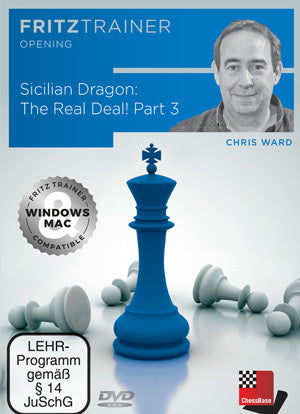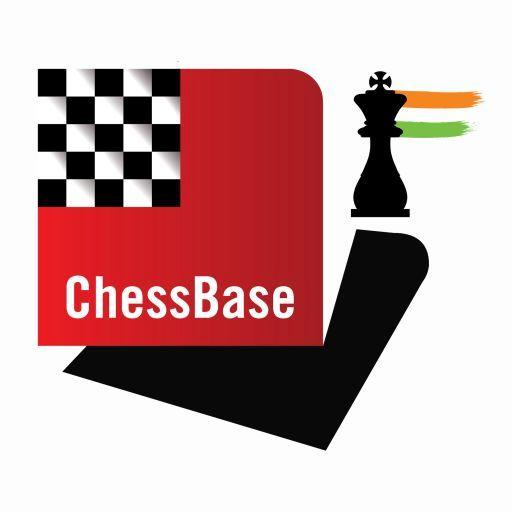Sicilian Dragon: The Real Deal! Part 3 by Chris Ward
Sicilian Dragon: The Real Deal! Part 3 by Chris Ward
Couldn't load pickup availability
Sicilian Dragon: The Real Deal! Part 3 by Chris Ward
Following on from ‘Part 1: Understanding The Dragon’ where important themes and concepts were explained, now it’s time to delve into the theory that has shaped this exciting opening over the years. From reasons why once popular variations are no more (but with revival suggestions!) to coverage of the more modern systems currently deployed by the World’s elite, this two-parter has it all!
Everybody loves Yugoslav Attack encounters and in this video course it is the sharp 9 Bc4 line that takes centre stage. Whilst these days most focus on the Soltis, Topalov and Chinese Variations, also covered here, other Black options similarly come under the microscope. Everything non-Yugoslav Attack is also then visited including the trendy ‘Long Castles Classical’ approach. With his constant monthly monitoring of Dragon games Worldwide on the chesspublishing site, Chris argues that rather than being analysed to death as many had predicted, in fact the opening has flourished in recent times with new ideas and variations frequently popping up. The viewer won’t be overwhelmed with myriads of moves to learn but with a nice choice of systems, will receive a good grounding in all chapters that can be used as a fantastic springboard for further investigation. There is simply no doubt that with these video courses assimilated, the user will be more ready than ever to enter the Dragon! Themes: Yugoslav Attack 9 Bc4, Classical and Fianchetto Systems
• Video running time: 6 hours (English)
• With interactive training including video feedback
• Extra: Training with ChessBase apps - Memorize the opening repertoire and play key positions against Fritz on various levels
Sample video
- Introduction
- Yugoslav Attack 9.Bc4
- 1.e4 c5 2.Nf3 d6 3.d4 cxd4 4.Nxd4 Nf6 5.Nc3 g6 6.Be3 Bg7 7.f3 0-0 8.Qd2 Nc6 9.Bc4
- Soltis Variation Part 1: 9...Bd7 10.h4
- Soltis Variation Part 2: 9...Bd7 10.0-0-0 Ne5 11.Bb3 Rc8 12.Kb1
- Chinese Variation Part 1: 9...Bd7 10.0-0-0 Rb8 11.Bb3 Na5 12.Kb1/g4
- Chinese Variation Part 2: 9...Bd7 10.0-0-0 Rb8 11.h4 b5 and 11.Bb3 Na5 12.Bh6
- Topalov System 9...Bd7 10.0-0-0 Rc8 11.Bb3 Nxd4 12.Bxd4 b5
- 9...Nxd4 10.Bxd4 Be6/Qa5
- Old Variations: 9...Nd7; 9...Bd7 10.0-0-0 Qb8/Qc7
- Old Variations: 9...Bd7 10.0-0-0 Rc8 without h5; 9...Bd7 10.0-0-0 Qa5
- 9...Bd7 10.Bb3 and h4
- Non-Yugoslav lines
- 1.e4 c5 2.Nf3 d6 3.d4 cxd4 4.Nxd4 Nf6 5.Nc3 g6
- Long Castles Classical Variation: 6.Be2 Bg7 7.Be3 Nc6 8.Qd2 0-0 9.0-0-0
- Classical Variation: 6.Be2 Bg7 7.0-0
- Modern Classical Variation: 6.Bc4
- Fianchetto Variation: 6.g3
- Levenfish 6.f4 and 6.Bg5
System requirements: Minimum: Pentium III 1 GHz, 2 GB RAM, Windows 7, DirectX9 graphic card with 256 MB RAM , Windows Media Player 9 and internet connection for program activation. Recommended: PC Intel Core i7, 2.8 GHz, 4 GB RAM, Windows 10, DirectX10 graphic card (or compatible) with 512 MB RAM or better, 100% DirectX10 compatible soundcard, Windows Media Player 11 and internet connection for program activation.
Information regarding product delivery
Information regarding product delivery
*Pre-ordered digital products will be delivered by email on the launch date of that product.
Digital Products (Softwares, Magazines, etc)
All digital products are delivered instantly. Once your payment is successfully processed, you will receive the following instantly via email:
- Serial key
- Setup files
- Installation procedure
Please ensure you provide the correct email address during checkout, as the serial key and files will be sent to that email address instantly upon successful payment.
Physical Products (Books, Chess Sets, etc)
These will be shipped to your address via third-party courier partners.
We dispatch all orders (except customised t-shirts) within 1-2 days. Orders placed on weekends and holidays may take 1-2 additional days to ship, as we do not operate on these days.
Delivery timelines are as follows:
- Standard Delivery (India): 7–10 working days
- Express Delivery (India): 2–5 working days
- International Shipping: Estimated 2 weeks (may vary based on destination and customs)
You will receive a tracking link via email once your order is dispatched.
Regarding MacOS compatibility for softwares
Regarding MacOS compatibility for softwares
Although not officially supported on Mac, there is a workaround that people find helpful. You can check it here.
Important note for international customers
Important note for international customers
We sell digital products (softwares) and most of our physical products only in the following 11 countries:
India, Bangladesh, Nepal, Bhutan, Maldives, Sri Lanka, Thailand, Indonesia, Pakistan, Malaysia, Philippines.
If you do not belong to any of these countries, you can still buy some high-quality products that we ship worldwide. Please check those out here.
- Trusted Since 2016
- Premium Quality
- Free Delivery
Share



